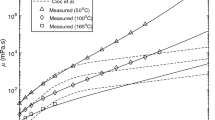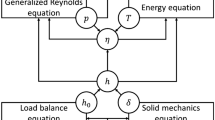Abstract
The solution of elastohydrodynamically lubricated contacts at high loads and/or low speeds can be described as a Hertzian pressure with inlet and outlet boundary layers: zones where significant pressure flow occurs. For the soft lubrication regime (elastic-isoviscous), a self-similar solution exists in the boundary layers satisfying localized equations. In this paper, the boundary layer behaviour in the elastic-piezoviscous regime is investigated. The lengthscale of the boundary layers and the scaling of pressure and film thickness are expressed in non-dimensional parameters. The boundary layer width scales as \(1/\sqrt{M}\) (equivalent to \({\bar{\lambda }}^{3/8}\)), the maximum pressure difference relative to the Hertzian solution as \(1 / \root 3 \of {M}\) (equivalent to \({\bar{\lambda }}^{1/4}\)) and the film thickness as \(1/\root 16 \of {M}\) (equivalent to \({\bar{\lambda }}^{3/64}\)) with \(M\) the Moes non-dimensional load and \({\bar{\lambda }}\) a dimensionless speed parameter. The Moes dimensionless lubricant parameter \(L\) was fixed. These scalings differ from the isoviscous-elastic (soft lubrication) regime. With increasing load (decreasing speed), the solution exhibits an increasing degree of rotational symmetry. The pressure varies less than 10 % over an angle less than 45 degrees from the lubricant entrainment direction. The results provide additional fundamental understanding of the nature of elastohydrodynamic lubrication and give physical rationale to the finding of roughness deformation depending on the “inlet length”. The findings may contribute to more efficient numerical solutions and to improved semi-analytical prediction methods for engineering based on physically correct asymptotic behaviour.
















Similar content being viewed by others
Abbreviations
- \(a\) :
-
Contact radius \(a=((3FR_x)/(2E'))^{1/3}\) (m)
- d :
-
Deformation (m)
- \(E'\) :
-
Equivalent Young’s modulus \(2/E'=(1-\nu _1^2)/E_1+(1-\nu _2^2)/E_2\) (Nm−2)
- F :
-
External load (N)
- h :
-
Film thickness (m)
- H :
-
Dimensionless film thickness \(H = hR_x/a^2\)
- H*:
-
Dimensionless film thickness \(H^{*}=H {\bar{\lambda }}^{-3/5}\)
- H M :
-
Moes dimensionless film thickness \(H_{\rm M}=h/R_x \cdot ((\eta _0 u_{\rm s})/( E' R_x))^{-1/2}\)
- \(\overline{H}\) :
-
Dimensionless film thickness \(\overline{H} = H\root 16 \of {M}\)
- \(\Delta H\) :
-
Dimensionless film thickness difference
- \(L\) :
-
Moes lubricant parameter \(L= \alpha \, E' \cdot (( \eta _0 u_{\rm s})/( E' R_x))^{1/4}\)
- \(M\) :
-
Moes load parameter point contact \(M = F/(E'\,R_x^2) \cdot (( \eta _0 u_{\rm s})/( E' R_x))^{-3/4}\)
- \(M_l\) :
-
Moes load parameter line contact \(M_1=w/(E' R_x) \cdot (( \eta _0 u_{\rm s})/( E' R_x))^{-1/2}\)
- \(p\) :
-
Pressure (Nm−2)
- \(P\) :
-
Dimensionless pressure \(P = p/p_h\)
- \(P^{*}\) :
-
Dimensionless film thickness \(P^{*}=P {\bar{\lambda }}^{-1/5}\)
- \(p_h\) :
-
Maximum Hertzian pressure \(p_h=(3F)/(2 \pi a^2)\)(Nm−2)
- \(P_h\) :
-
Dimensionless Hertzian pressure distribution \(P_h=\sqrt{1-X^2-Y^2}\)
- \(\Delta P\) :
-
Dimensionless pressure difference \(\Delta P\,=\,P(X,Y)-P_h\)
- \(\overline{\Delta P}\) :
-
Dimensionless pressure difference \(\overline{\Delta P}\, = \Delta P \root 3 \of {M}\)
- \(r\) :
-
Dimensionless radius \(r=sign(X) \sqrt{X^2+Y^2}\)
- \(R_x\) :
-
Reduced radius of curvature in \(x\) \(1/R_x=1/R_{1x}+1/R_{2x}\) (m)
- \(Re_x\) :
-
Local Reynolds number (introduction) \(Re_x=u_\infty x/\nu\)
- \(R_y\) :
-
Reduced radius of curvature in \(y\) \(1/R_y=1/R_{1y}+1/R_{2y}\) (m)
- \(u\) :
-
Surface velocity (ms−1)
- \(u_{rm s}\) :
-
Sum velocity \(u_{\rm s}=(u_1+u_2)\) (ms−1)
- \(u_\infty\) :
-
Freestream velocity (introduction) (ms−1)
- \(w\) :
-
External load per unit width (line contact) (Nm−1)
- \(x\) :
-
Coordinate in the direction of rolling (freestream flow) (m)
- \(y\) :
-
Coordinate perpendicular to the direction of rolling (freestream flow) (m)
- \(x'\) :
-
Coordinate in the direction of rolling (m)
- \(y'\) :
-
Coordinate perpendicular to the direction of rolling (m)
- \(X,Y\) :
-
Dimensionless coordinates \(X = x/a\), \(Y = y/a\)
- \(X',Y'\) :
-
Dimensionless coordinates \(X' = x'/a\), \(Y' = y'/a\)
- \(\overline{X}\) :
-
Dimensionless scaled coordinate \({\overline{X}} =\mp 1 + (X \pm 1) \sqrt{ M}\)
- \(X^{*}\) :
-
Dimensionless coordinate \(X^{*}=(X \pm 1) {\bar{\lambda }}^{-2/5}\)
- \(z\) :
-
Viscosity pressure index (Roelands)
- \(\alpha\) :
-
Viscosity-pressure coefficient (N−1m2)
- \({\bar{\alpha }}\) :
-
Dimensionless viscosity index \({\bar{\alpha }}=\alpha p_h\)
- \(\eta\) :
-
Dynamic viscosity (Nm−2s)
- \(\bar{\eta }\) :
-
Dimensionless viscosity \(\bar{\eta }= \eta /\eta _0\) (Nm−2s)
- \(\eta\) :
-
Boundary layer dimensionless coordinate (introduction) \(\eta =y \sqrt{u_\infty /(\nu x)}\)
- \(\nu\) :
-
Kinematic viscosity (introduction) \(\nu =\eta /\rho\) (m2s)
- \(\phi\) :
-
Angle with \(X\) axis \(\phi = \arctan (Y/X)\)
- \({\bar{\lambda }}\) :
-
Dimensionless speed parameter \({\bar{\lambda }}=(6\eta _0 u_{\rm s} R^2_x)/(p_h a^3)\)
- \(\rho\) :
-
Density (kg m−3)
- \(\bar{\rho }\) :
-
Dimensionless density \(\bar{\rho }= \rho /\rho _0\)
- \(\nu\) :
-
Poisson ratio
- \(\Delta\) :
-
Dimensionless mutual approach
- \(0\) :
-
At ambient pressure
- \(1,2\) :
-
Surface 1, surface 2
- s:
-
Sum
- \(x\) :
-
In \(x\) direction
- \(y\) :
-
In \(y\) direction
References
Dowson, D., Higginson, G.R.: New roller-bearing lubrication formula. Engineering 192(4972), 158–159 (1961)
Hamrock, B.J., Dowson, D.: Isothermal elastohydrodynamic lubrication of point contacts, part III, Fully flooded Results. ASME J. Lubr. Technol. 99, 264–275 (1977)
Chittenden, R.J., Dowson, D., Dunn, J.F., Taylor, C.M.: A theoretical analysis of the isothermal elastohydrodynamic lubrication of concentrated contacts I. direction of lubricant entrainment coincident with the major axis of the Hertzian contact Ellipse. Proc R Soc Lond A 397, 245–269 (1985)
Nijenbanning, G., Venner, C.H., Moes, H.: Film thickness in elastohydrodynamically lubricated elliptic contacts. WEAR 176, 217–229 (1994)
Chevalier, F., Cann, P.M.E., Colin, F., Dalmaz, G., Lubrecht, A.A.: Film thickness in starved EHL point contacts. ASME J. Tribol. 120(1), 126–133 (1996)
Damiens, B., Venner, C.H., Cann, P.M.E., Lubrecht, A.A.: Starved lubrication of elliptical EHD contacts. ASME J. Tribol. 126(1), 105–111 (2004)
Jacod, B., Venner, C.H., Lugt, P.M.: A generalized traction curve for EHL contacts. ASME J. Tribol 123, 248–253 (2003)
Greenwood, J., Morales-Espejel, G.E.: The behaviour of transverse roughness in EHL contacts. Proc. IMechE J. Eng. Tribol. 208, 121–132 (1994)
Hooke, C.J., Venner, C.H.: Surface roughness attenuation in line and point contacts. Proc. Inst. Mech. Eng. J. Eng. Tribol. 214, 439–444 (2000)
Venner, C.H., Lubrecht, A.A.: An engineering tool for the quantitative prediction of general roughness deformation in EHL contacts based on harmonic waviness attenuation. Proc. ImechE. Part J: J. Eng. Tribol. 219, 303–312 (2005)
Masen, M.A., Venner, C.H., Lugt, P.M., Tripp, J.H.: Effects of surface micro-geometry on the lift-off speed of an EHL contact. STLE Tribol. Trans. 45(1), 21–30 (2002)
Glovnea, R.P., Choo, J.W., Olver, A.V., Spikes, H.A.: Compression of a single transverse ridge in a circular elastohydrodynamic contact. ASME J. Tribol. 125, 275–282 (2003)
Sperka, P., Krupka, I., Hartl, M.: Experimental study of real roughness attenuation in concentrated contacts. Tribol. Int. 43, 1893–1901 (2010)
Venner, C.H., ten Napel, W.E.: Multilevel solution of the elastohydrodynamically lubricated circular contact problem, part II: Smooth surface results. WEAR 152, 351–367 (1992)
Biboulet, N., Sperka, P., Venner, C.H., Lubrecht, A.A., Krupka, I.: Obtaining the pressure spike and maximum shear stress from optical interferometry data. Tribol. Int. 62, 1–7 (2013)
Mora, F., Sainsot, P., Le Chenadec, Y., Lubrecht, A.A.: Lubrication of 2D soft elastohydrodynamic contacts: extension of the amplitude reduction theory. Proc. Inst. Mech. Eng. 226, 769–774 (2012)
Howison, S.: Practical applied mathematics: modelling, analysis, approximation, Cambridge University Press, Cambridge, UK, ISBN 139780521842743 (2005)
Holmes, M.H.: Introduction to perturbation methods, Springer, text in applied mathematics, 20, Springer, New York, USA. ISBN 9781461454762 (1995).
Schlichting, H., Gersten, K.: Boundary-Layer Theory, McGraw Hill, New York, USA, ISBN 978-3-540-66270-9 (2000).
Bretherton, F.P.: The motion of long bubbles in tubes. J. Fluid Mech. 10, 166–188 (1961)
Dowson, D., Higginson, G.R.: The effect of material properties on the lubrication of elastic rollers. J. Mech. Eng. Sci. 1(1), 6–15 (1960)
Eggers, J., Fontelos, M.A.: The role of self-similarity in singularities of partial differential equations. Nonlinearity 22, R1–R44 (2009)
Hooke, C.J.: The elastohydrodynamic lubrication of heavily loaded contacts. J. Mech. Eng. Sci. 19(4), 149–156 (1977)
Bisset, E.J.: The line contact problem of elastohydrodynamic lubrication. I. Asymptotic structure for low speeds. Proc. Roy. Soc. Lond. A 424, 393–407 (1989)
Bisset, E.J.: The line contact problem of elastohydrodynamic lubrication. II. Numerical solution of the integrodifferential equations in the transition and exit layers. Proc. Roy. Soc. Lond. A424, 409–429 (1989)
Kudish, I.I., Covitch, M.J.: Modeling and Analytical Methods in Tribology. Chapman and Hall/CRC, Boca Raton (2010)
Kudish, I.I.: Asymptotic analysis of lubricated heavily loaded point contacts. Lub. Sci. (2013)
Venner, C.H., Lubrecht, A.A.: Revisiting film thickness in slender EHL contacts. Proc. ImechE. Part C: J. Mech. Eng. Sci. 224, 2549–2558 (2010)
Snoeijer, J.H., Eggers, J., Venner, C.H.: Similarity theory of lubricated Hertzian contacts. Phys. Fluids 25, 101705 (2013)
Herrebrugh, K.: Solving the incompressible and isothermal problem in elastohydrodynamic lubrication through an integral equation. ASME J. Tribol. 90, 262–270 (1968)
Dowson, D., Higginson, G.R., Whitaker, A.V.: Elastohydrodynamic lubrication: a survey of isothermal solutions. J. Mech. Eng. Sci. 4(2), 121–126 (1962)
Roelands, C.J.A., Correlational aspects of the viscosity-temperature-pressure relationship of lubricating oils, PhD. Thesis, Technical University Delft, The Netherlands (V.R.B. Groningen, The Netherlands) (1966).
Brandt, A.: Multi-Level adaptive Solutions to boundary value problems. Math. Comp. 31(2), 333–390 (1977)
Brandt, A., Lubrecht, A.A.: MultiLevel matrix multiplication and fast Solutions of integral equations. J. Comp. Phys. 90(2), 348–390 (1990)
Venner, C.H. and Lubrecht, A.A.: MultiLevel methods in lubrication, Elsevier Tribology Series, 19 (2000)
Venner, C.H., ten Napel, W.E.: Numerical calculation of the pressure spike in elastohydrodynamic lubrication. Lubr. Sci. 2(4), 321–335 (1990)
Author information
Authors and Affiliations
Corresponding author
Rights and permissions
About this article
Cite this article
Venner, C.H., Biboulet, N. & Lubrecht, A.A. Boundary Layer Behaviour in Circular EHL Contacts in the Elastic-Piezoviscous Regime. Tribol Lett 56, 375–386 (2014). https://doi.org/10.1007/s11249-014-0415-z
Received:
Accepted:
Published:
Issue Date:
DOI: https://doi.org/10.1007/s11249-014-0415-z




